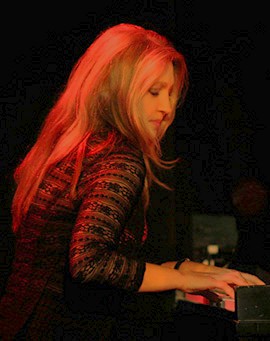
|
| Eliane Elias |
Eliane Elias: powerhouse
pianist, vocalist, and composer. Her album "Something for You" is a tribute to Bill Evans.
 |
 |
|
"Music is enough for a lifetime-- but
a lifetime is not enough for music." - Sergei Rachmaninoff
|
|
 |
 |
The function of music
is to release us from
the tyranny of conscious thought.
When "blindfold tests" were popular
among jazz critics, record aficionados, and self-styled experts, there were arguments, confusions, debates (and bets) regarding
the identity of the performing artists. Duke Ellington shook his head and summed up the situation by saying "If
it sounds good, it is good."
Amen to that.
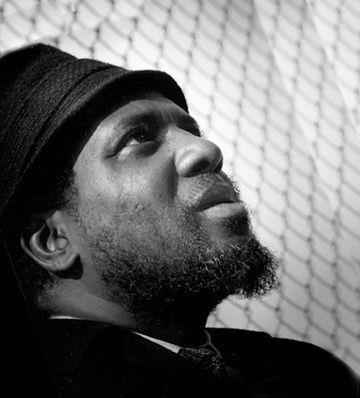
|
| Thelonious Sphere Monk |
"Those who want to know what sound goes into my music should come to
New York and open their ears."
- Thelonious Monk
Musical instrument extraordinaire:
Here you can see the rythym exgravaganza slated for the Smithsonion
Museum? It was a collaborative project of the Music Conservatory and the School of Engineering at the University of Iowa.
Students spent six years to set up the alignment, calibration, tuning and computer-generated programs. Many off-beat materials
were used in the construction, includinge pvc pipes from irrigation equipment.
You have to see and hear this. Turn on your speakers!
go to Instrument Extraordinaire
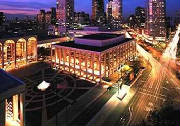
|
| Lincoln Center. Photo: David Lamb. |
Lincoln Center is the
world's largest performing arts center-- home to the New York Philharmonic Orchestra, New York City
Ballet, and the Met.
go to Lincoln Center
go to Jazz at Lincon Center

|
| Darcy James Argue |
What's the future sound?
One clue may be Darcy James Argue, 33. His 18-piece
steampunk big band, "Secret Society," has captured the hearts of music critics for it's breakthrough sound.
No genre atrophy here; no same'ole same'ole. His sound calls for new neuron connectivity.
"Infernal Machine" is his debut
recording on the intriguing New Amsterdam label. Newsweek's Seth Colter Walls
raved, calling Argue a musical free-thinker with 'wholly original inventions.' New York Times said "Jazz great of tomorrow,"
and New York's Time Out: called him "The one to watch."
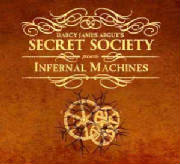
go to Argue on MySpace
"Play every note as if
your life depended on it."
- Charlie Haden
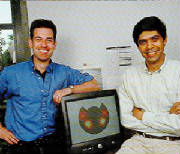
|
| Neuroscientists Iversen and Patel. |
Our Sound Minds
The study of music and the brain is yielding answers. Researcher
Aniruddh Patal says: "Humans are the only species to spontaneously synchronize
their movements with music and rhythm.
"We’re trying to understand what special aspect of the brain
allows it to hear a beat in sound and how the process can shed light on the complex interaction of the sensory and motor systems."
How are our auditory and motor systems coupled?
Rhythm is not just found in music. It’s coherent in all
our motions– in speech, walking, dance or any other physical movement.
John Iversen, who is working
with Patel at The Neuroscience Institute, says: "Understanding how the brain processes rhythm to aid motion could lead to
expanding treatments of Parkinson’s and other movement disorders."
Frequency-tagging
is conducted with the aid of a MEG brain scanner, which records how humans perceive the ‘beat’ in music.
MEG is the smart way to say magnetoencephalography.
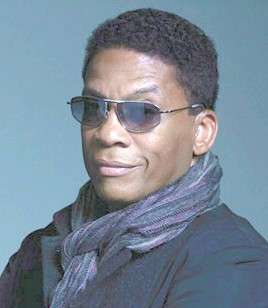
|
| Herbie Hancock |
Herbie Hancock snagged the Grammy
for album of the year. After 40 years of transforming album work, it's about time. We know
that the "best album" category is often chosen as a corrective for shortcomings in the past. Jazz is long overdue for that.
And Herbie's the man.
The prize went to "River: The Joni Letters," with Joni
Mitchell songs sung by Norah Jones, Tina Turner, Leonard Cohen, and others-- an album of modest sales compared with nominees
with millions more.
For a progressive pianist and composer of the first order his Grammy
may be a histrory-minded celebration of his role in the 'album culture.' Hancock is also an Oscar winner for the best original
score for "Round Midnight."
go to Herbie Hancock
go watch Herbie Hancock play Watermelon Man
The
Local Community Radio Act is a must for musicians. Learn more:
go to Free Press Music
go track legislation
Every great hall shapes its distinct sound.
Performers and audiences hear it-- feel it.
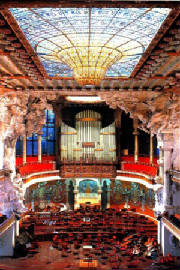
|
| The Palace of Music in Barcelona was built for singers. |
The Sound of Venue
Some of the greatest sounding halls were built in the 19th century
when engineering techniques were in their infancy. There was virtually no practical scientific knowledge of acoustics. Many
argue that we've been backsliding ever since, despite our sophisticated sound technology.
Standards of Excellence
Devotees of symphony orchestras know a full sound when they hear
it. And they often agree with acoustics pros when rating concert halls. A list of favored sites usually includes Grosser
Musikvereinssall (Vienna, 1870), Gewandhaus (Leipzig, Germany, 1885), the Concertgebouw
(Amsterdam, 1895), and Symphony Hall in Boston (1900).
Each of these halls has a great resident orchestra. All were built
from standard construction materials of their day, and their interiors share roughly the same aspect and proportions.
Why do these halls surpass those of more recent vintage? That question
has been asked for a hundred years-- and the answers have brought us full circle to where we were a century ago.
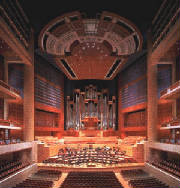
|
| Meyerson Symphony Hall, Dallas. |

|
| Disney Concert Hall, Los Angeles. |
more on Disney Conert Hall
Bright or mellow?
Your choice.
Our ears are accustomed to hearing
the everyday mix of radiated and reflected sound. Radiated sound from the primary source sets the
volume level– and we're not really aware of reflected volume.
At a concert we are quieter, calmer, and concentrated--
so our perception of subtleties is higher. For the sound to seem natural, the proportion
of the two volume levels needs to be lowered.
If the equalization of a hall is correct, sound from the stage will reach
the audience in the same volume relationship, without distortion.
Sounds radiates differently, depending on
vibrations. Lower vibrations radiate almost equally in all directions. Higher vibration frequencies radiate directly in a
straight line.
Ideally, a concert hall is designed so that high frequencies coming from
reflective surfaces are subdued– thus mellowing the sound.A hall’s characteristic
acoustic is determined by the first reflection of a radiated sound. If the volume of the reflected
sound is loud enough to be perceived by the listener, there is reverberation– which is always a problem.
In ‘bright’ halls, hard accents
and biting attacks sound overly harsh and stringent, and musicians have to ‘tamp down’ to be listenable. In ‘mellow’ halls, musicians are able to play full out for a big tone in a wide range of dynamics.The pertinent factor is time. The interval
between the arrival of sound and it’s bounce is a function of the size and shape of a hall.
Size and Shape
It would be great if acoustical engineers could measure the time interval
between the first arrival of direct sounds and the next few arrivals of reflected sounds, with their volume levels. But it’s impossible to establish a single reflection time because audience members sit at different
distances from the reflective surface of ceilings, side walls, back walls, and the wall behind the performers. And the arrival
of reflected sounds are so close together they can’t be registered separately. On paper, the result is a blur.
Sound science can only go so far. When architects and acoustic pros team
up, the synthesis of their disciplines, historical knowledge, detailed models, computer simulations,
and hunches fill the gap of imperfect testing.
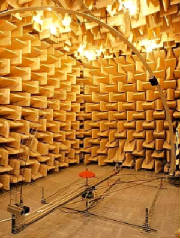
|
| Acoustic testing chamber. |
Anechoic
chambers isolate external sound.
The idea is to create an echo-free space with minimum reflected sound and reverberation.
(say an-a-KOE-ik)
In 1951, composer John Cage entered
Harvard's anechoic chamber. He expected to hear nothing. Instead he heard what he believed to be the sound of his own bloodflow
and nervous system. The experience inspired his composition, 4'33".

|
| Pioneer chamber at McIntosh |
Anechoic chambers are used for designing recording
studios, testing audio equipment, and other sound-analysis purposes, such as testing hearing aids.
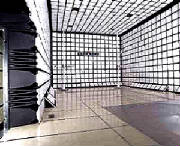
|
| TDK anechoic chamber |
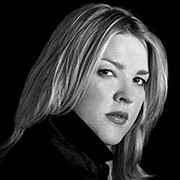
|
| Diana Krall / Mrs. Elvis Costello |
"If I fell under the spell of your call I would
be caught in the undertow. So you see, I've got to say No No; all or nothing at all."
It's the last verse in the Lawrence/Altman tune from
1939, and a keeper in Krall's repertoire. Well, she had to say yes to Elvis (they were married in December '03) and, happily,
she has not been pulled out to sea.
more on Diana Krall
go to Diana Krall
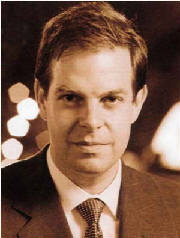
|
| Pianist Bill Charlap |
The complete musician.
Breathtaking soloist and renowned vocal accompanist also has a great
trio. His latest CD release is "Bill Charlap Plays George Gershwin." Listen and learn, and
say SHAR-lap.
go to Bill Charlap
more on Bill Charlap
more on Charlap's Trio
Enter
Accujazz, the world's only multi-channel mainstream jazz radio statiion. It really delivers. Click and listen.
go to Accujazz
more on ancient vibrations
"If a composer could say what he had to say in words,
he would not bother trying to say it in music."
- Gustav Mahler
When the lights dimmed
at the Carlyle.
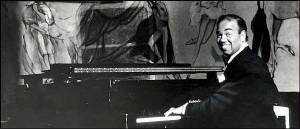
|
| Bobby Short (1924-2005) |
Anyone who knows the delight of a cabaret knows
that the Carlyle Hotel on New York City’s Upper East Side houses the gem– that paneled
room of murals wherein the elegant Bobby Short sat at the Baldwin grand and sang his heart out for 35
years.
more on Bobby Short
go to Bobby Short interview on NPR
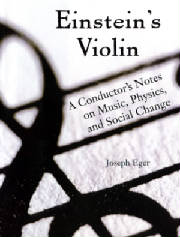
|
| Symphony conductor Joseph Eger merges Physics and Music. |
Symphony conductor Joseph Eger's Notes on Music, Physics,
and Social Change:
more on "Einstein's Violin"
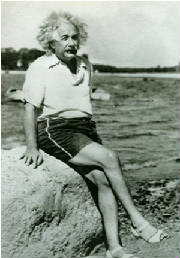
|
| Violinist Albert Einstein. |
The Acoustical Society of America keeps an inventory
of sounds-- from whales to fire ants to cellos.
go to ASA sounds
Pandora is a personal internet radio choice.
It's the end result of the hugely ambitious Music
Genome Project which classified all known music into hundreds fo specific dynamic categories and artists. You'll find
your music here.
go to Pandora
go to the Music Genome Project

|
| Amy Winehouse |
British singer-songwriter Amy Winehouse
won 5 grammies for "Rehab" and topped the UK album charts with "Back to Black." She died of a drug overdose in July 2011.
go to Amy Winehouse
|
 |
 |
 |
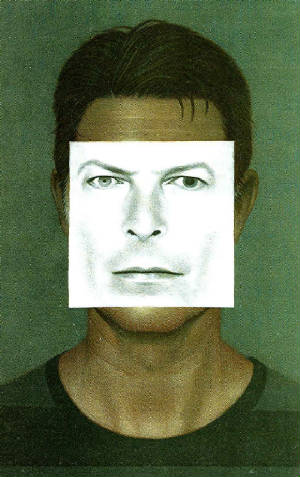
|
| Illustration: Thomas Ehretsmann |
David Bowie triumphs with "The Next
Day," an album that reflects back and charges into the future with "The Stars Are Out Tonight."
go to Bowie in The Rolling Stone
An astonishing history of the 20th century as told through its music:
Alex Ross is an award-winning music critic and author of "The
Rest is Noise: Listening to the Twentieth Century" and "Listen to This."
Both demonstrate such a sweeping knowledge, insight, and passion that
his books are not just exciting for a music lover to read, but have become instant classics in music and cultural history.
From a critic for The Economist: "He has an almost uncanny gift for
putting music into words." Geoff Dyer, in his New York Times Review, wrote "Ross enables us to listen more hearingly."
Ross is also generous with his readers in sharing external links. Here
are two that you will find nowhere else.
go to Glossary of Music Vocabulary
go to Access to Music Critics and Music Sites
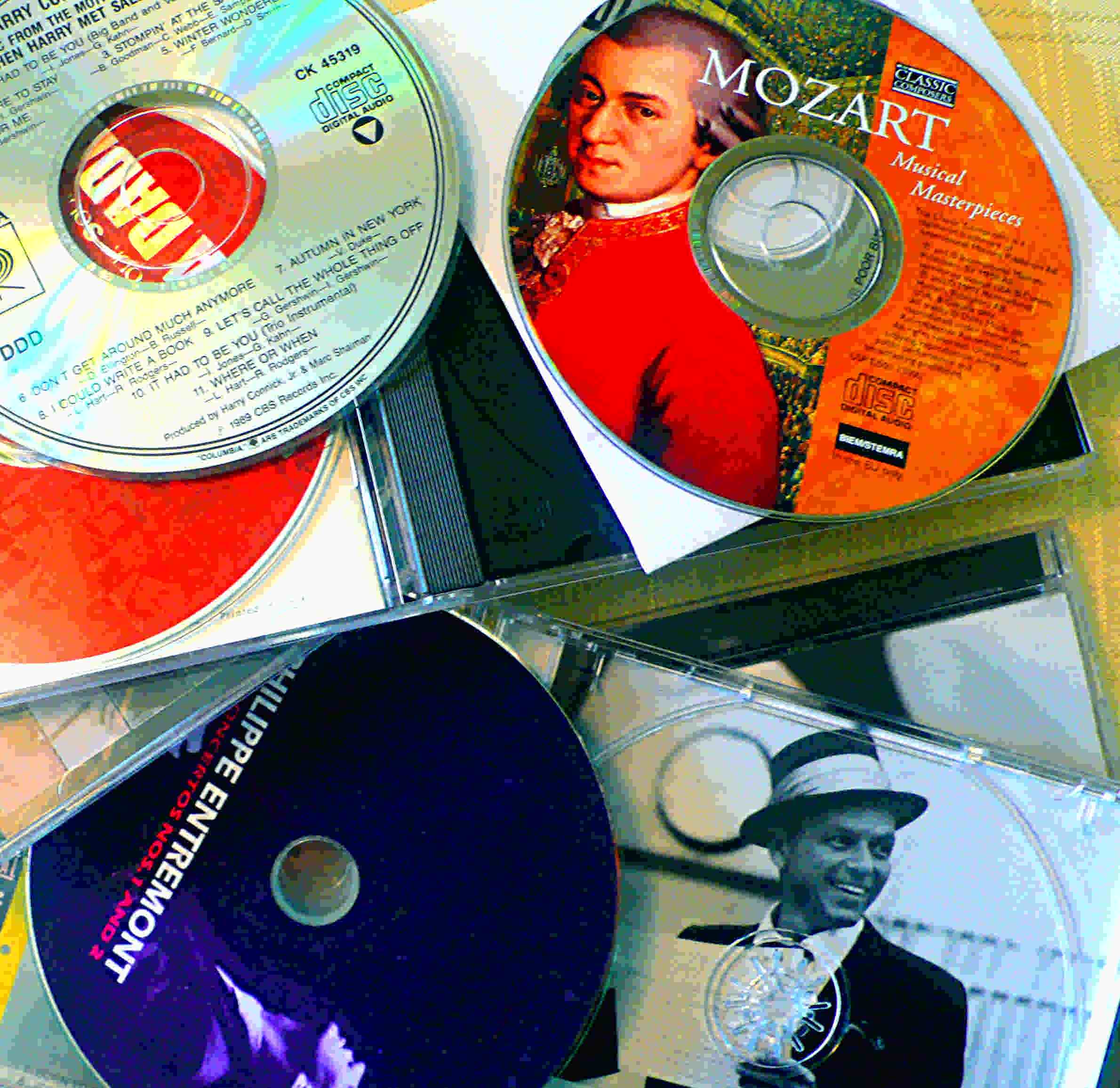
Demise of CDs.
The descent of the compact disc has been swift. Tower, Borders, Virgin,
and other music chains have shut down, iTunes is now the world’s biggest music retailer, and streaming services like
Spotify are on the rise.
Digital sales first outstripped CD sales in 2011.
Accelerated discount pricing for discs continues to push down profits. (Plus, practically speaking, there’s a common
aversion to scratches and cracks in the damnable euphemistically-called ‘jewel cases.’)
A major label executive says "We’re not in the CD
business– we’re in the music business. Anyone still betting their future on the CD aspect of the business is toast."
Some regional and local retailers are ‘hanging in.’ The California
chain Amoeba Music still sells hard copies to customers who don’t see the point of paying a dollar for a song or a single
cut of an album in mid-air.
Older music fans are still filling out their collections of physical
objects. Walmart and Target are restoring floor space for CD displays. And there’s still a market for deluxe versions
of hits with bonus tracks or DVDs on Amazon.
But the overall assessment is that there’s no more than three to
five years left in the CD market after which they will spend their ‘retirement’ as collectors' items, nudging
over the 45's and LPs.
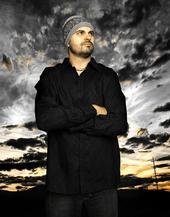
|
| Anthony Smith, keyboard wizard and composer-lyricist phenom. |
Anthony Smith's jam band, Trunk Fulla Funk, owns its rock'n
soul groove. In "Life As We Know It," Smith wrote, arranged, and mixed all 13 tracks-- giving the piece a searing, rhapsodic
cohesiveness.
Walt Williams, on lead vocals, is reminiscent
of the sweetness of early Stevie Wonder-- but with a knowing street angst. The album's title comes straight from the musicians'
stories. Lyrics are deep and searing-- expressing the dreams and energies of a working, traveling musician in an often tuned-out
nation.
Smith's dazzling keyboard artistry is heard on acoustic
piano, the Hammond B-3, Fender Rhodes, Werlitzer, and the Korg M-3 and MS-2000. He's way past a triple treat.
go to Anthony Smith

|
| Lyrical photography of Jatin Kampani |
"Jazz is a spirit. It is freedom. It is reality put into
musical form. It will never leave until this planet leaves."
- Sonny Rollins
"It's the hidden things, the subconscious that lies in
the body and lets you know. You feel this; you play this."
- Ornette Coleman
Carnegie Hall's program "Music Explore"
is for 1st and 2nd graders. The kids have an opportunity to visit the hall for exposure to the world of artists. They sing
songs, learn about instruments and are immersed in the pleasure of music. Someone in the group may be one of tomorrows great
artists.
Amped.
Bands in the post-hardcore underground in the 80's and 90's were LOUD.
Few players wore earplugs. Thundering loudness amped up adreneline. Extreme volume was macho even though ears were roasting
from the decibels. Equally dramatic was the feedback which could induce near-emesis.
Pat Mahoney, drummer for LCD Soundsystems says that his surrounds were
so loud and his ears so fatigued that he began to feel as if his auditory nerves were 'snow blind.' Through the cacophany
he couldn't identify the sounds.
Now these musicians must be wary of stumbling because of the deranged
whorls of plumbing in their ears that govern balance.
There is nothing to hear-- except a continually ringing tone. And when
they try to speak over it, they have to shout to hear themselves. When they're in a crowded room they shout to be heard.
Guitarist Jon Fine says he "gave his ears to rock and roll," although
he accepts the physical penalty without complaint. Sometime he cranks up the volumne to hear music--- and hopes that
nothing too bad will happen.
go to protect hearing
Rock off?
Conert attendance is dropping, ticket prices are dipping, and artists
are cancelling shows.
'Live Nation,'
the world's largest show promoter, controls 40 of the nation's amphitheaters-- with each holding about 20 thousand fans. What
a bummer when the place is less than half full. Competitor 'AEG Live' specializes in indoor arena
shows, and it too is finding it harder to fill the house.
Since a big piece of revenue goes to performers, promoters typically
jack up the price of parking, food, and drinks to make ends meet. Reasonable prices and terrific venues are the way to
go. Anything less will finish off business.
In the world of I-Phones, I-Tunes, YouTube, Bluetooth,
Twitter, and a dazzling array of local bands, the big promoters can no longer sit back and take success for granted.
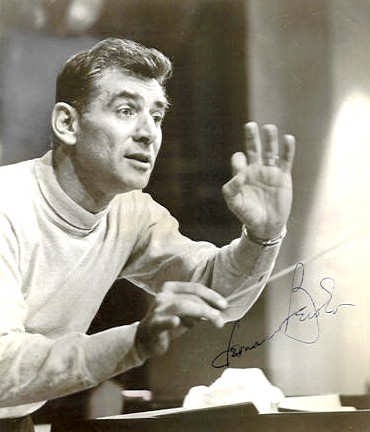
|
| Conductor Leonard Bernstein |
Leonard Bernstein's legacy
and reputation have only grown since his death. Carnegie Hall recently honored him with a festival: "Bernstein:
The Best of All Possible Worlds." His children have donated his composing studio to Indiana University, where it will be recreated.
Music lovers around the world are
celebrating the 90th anniversary of his birth. The Joy of Music lives on.
go to schedule of events
more on Lenny Bernstein
Remembering John Lennon:
"Sometimes you wonder, I mean really wonder. I know we make our own
reality, and we always have a choice, but how much is preordained? Is there always a fork in the road, and are there two preordained
paths that are eqully preordained?
"There could be hundreds of paths where one could go this way or that
way-- there's a choice, and it's very strange sometimes."
- John Lennon,
December 5,1980 interview with Jonathan Cott of Rolling
Stone.
go to Rolling Stone and listen to the interview
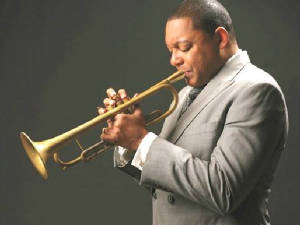
|
| Wynton Marsalis: musician, educator, and activist. |
The arts are revenue-and job-generating dynamos. They deserve
more recognition and support.
As Artistic Director of Jazz at Lincoln Center, Wynton
Marsalis is a vital force in boosting public support of the arts. His keynote speeches often have more notes than words--
for he mixes text and trumpet to elucidate the collective treasure of our music.
In a recent lecture entitled "The Ballad of
American Arts," he told how "arts make us into one people, to teach us who we are." He illustrated key points
with his quintet. The next day he testified before Congress to lobby arts appropriations.
more: transcript of Wynton Marsalis speech "The Ballad of American Arts"
go to Wynton Marsalis

|
| Suntory Hall, Tokyo. Click to enlarge. |
Virtual tours of concert halls:
more on the sound of venue

|
| Jazz Heritage Center in San Francisco. |
Rebirth of the Cool
San Fraincisco has a new Historic Jazz Preservation
District-- and, after 20 years of struggle, a Jazz Heritage Center with a "Lush Life
Gallery" of art, a screening room, and a jazz history center. Executive Director Peter Fitzsimmons says "We're celebrating
the past but we're advocating the future of jazz." It's in a multi-use complex at the corner of Fillmore and Eddy in a 13-story
building with condos, underground parking, Yoshi's Jazz Club, and the Blue Mirror restaurant. Lots
of sparkle and pizzazz.
go to Jazz Heritage Center
go to Yoshi's jazz club
go to Appassionata, 3d movement by Claudio Arrau
go to Symphony No.9, Herbert von Karajan, conductor
go to Triple Concerto for violin, cello, and piano: Itzhak Perlman, Yo-Yo Ma, and Daniel Barenboim

|
| Lyricist-singer Sara Tavares |
Portuguese guitarist, singer, and songwriter Sara
Tavares is rocking Europe with her zizomba. Use OUR LINKS to sample tunes from Africa,
the Middle East, Oceania, South America, Asia, and points in between. Listen to dozens of genres from A (aboriginal) to Z
(zydeco).
Enjoy the world's music!
go to Global Music
go to World Connections
go to World Music at National Geographic

The
nitty-gritty of acoustics:
A pianist strikes a key and sound radiates in all directions. The shortest
path leads to the listener’s ear. The first reflected sound bounces from piano to wall to ear like
the trajectory of a billiard ball a fraction of a second later.
The ideal time delay for that reflected wave
is about .025 second after the direct hit. That delay, multiplied by the speed of sound in air (eleven-hundred
feet a second) says that the detour to the wall should add an extra 27 feet to the wave's
path. This helps to figure the ideal size of a concert hall.
The immediacy of sound to
the listener is enhanced when the nearest reflecting surfaces are close by. (Balconies often offer
the best seats in the house because they're closer to the ceiling.)
Any delay above a tenth of a second is perceived
as an echo. The best fullness-of-sound experience for a listener is to receive many reflections at very short term
intervals from all directions.
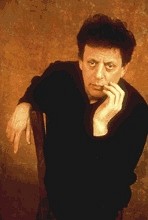
|
| Philip Glass |
Composer Philip Glass
travels to soak up the sounds of music. His recent symphony was inspired by the music of the Toltec people of central Mexico.
The piece lasts a mere 30 minutes, a short 'sit' compared to his five-hour "Einstein on the Beach."
more on Philip Glass
"I want to lose myself more and more in the
bliss of the music. Not only do I benefit from the intoxication, but the audience resonates with their own bliss. In
this way, the music wakes us all to who we really are."
- Kenny Werner
"Only art and science
give us intimations
and hopes . . .
of
a higher life."
-
Ludwig Van Beethoven
"You've got to find some
way of saying it without saying it."
- Duke Ellington
Great Performers
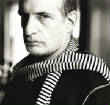
|
| Donald Fagen |
Fagen doesn't quit. His new album "Morph the Cat"
puts him back in the Steely Dan groove. Amen to that. We need his good vibes now more than ever.
go to Nightfly Trilogy
go to BBC review
From the Boston Globe: Steely Dan's detached cool still
plays well. "Supreme cool is an ineffable quality. But you know it when you see it, or hear it, and Steely Dan --
a.k.a. singer-keyboardist Donald Fagen, guitarist Walter Becker, and, this time out, 10 sublime servants of a singular legacy
-- had it in spades during a sharply focused two-hour performance."
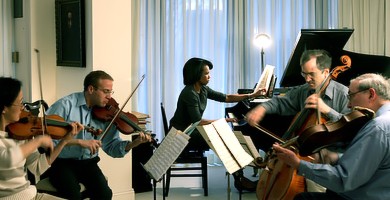
|
| High-powered Quintet |
Pianist and Former Secretary
of State, Condoleeza Rice, is a prominent amatuer musician and performs with her chamber group
at least twice a month. From left: Soye Kim, Joshua Klein, Robert Battey, and Lawrence Wallace.
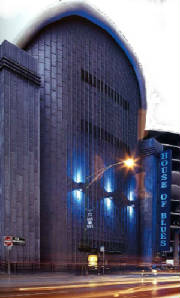
|
| House of Blues in Chicago |
The Blues moved from the fields of Louisiana to Congo Square in New
Orleans (now called Armstrong Park). Then the music traveled up the Mississippi River to St. Louis,
and up the Illinois River to Chicago, where it settled into its northern outpost and found its
home. In Chi town the great blues bands play with grit.
The House of Blues venue sits next to the corncob building at the Chicago
River and serves up Cajun. When local bands let loose it’s as real as it gets. Try to catch "Skip
Towne & the Greyhounds."
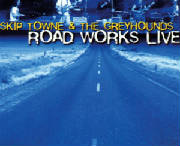
|
| Skip Towne and the Greyhounds' ROAD WORKS LIVE |
go to hear Skip Towne
Birds tweeting? Glass breaking? Foghorn? Maynot
be music to your ears-- but, you can search the web for hundreds of sounds.
go to Find Sounds
Enjoy jazz festivals?
|
 |
 |
 |
|
Riccardo Muti is music director and
conductor of the Chicago Symphony Orchestra, which he led to open the 2013 season of Carnegie Hall with Carl Orff's "Carmina
Burana."
His thoughts on conducting:
"Because you are in front of fantastic musicians
they know exactly what you're doing.
"They have their own ideas about the interpretation,
so the conductor has to bring the musicians to his ideas-- not necessarily convincing them that it is the only possible
idea or the only good idea-- but that this is one possible idea so convincing that-- they can follow you."
The Italian conductor mastered Latin and Greek in university;
his musical trajectory was from violin to piano to conductor. He was music director of the Milan Symphony at La Scala
for nineteen years.
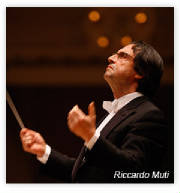
go to Muti interview on Charlie Rose
go to Muti on Carl Orff's "Carmina Burana" on YouTube
go to Riccardo Muti site
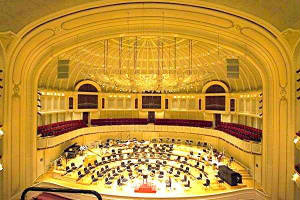
|
| Chicago Symphony Hall |
go to Chicago Symphony Orchestra
go to listen and watch Muti in Chicago
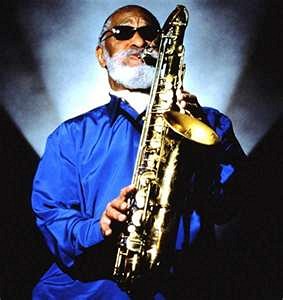
|
| Sonny in his 'zone.' |
Theodore Walter Rollins, aka Sonny Rollins,
aka Colossus, has been thrilling audiences for more than six decades. His musical evolution is the story of 20th century jazz,
and beyond. He was named a Kennedy Center Honoree on his 81st birthday. It's about time.
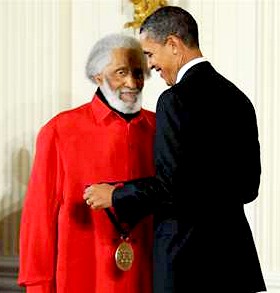
|
| Barack Obama awards the National Medal of Arts to Sonny Rollins. |
Thank you Sonny,
The sound of Sonny Rollins' tenor sax is known around the world-- live
and recorded. Sometimes he takes a break from performing to rethink and rewind, then returns to center stage recharged with
wise nuance. Personal and musical growth are as one.
He makes huge demands on himself and has always been a striver. Never on automatic, he goes deep into majesty. When he becomes profoundly immersed
in his groove, he's in another place. Some writers call it 'grandeur.'
Music critic Stanley Crouch tried to dig to the core in a New Yorker
profile of Rollins. In it he wrote:
"Over and over, decade after decade, from the late seventies through the eighties and nineties, there he
is. Sonny Rollins, the saxophone colossus, playing somewhere in the world, some afternoon or some eight o'clock somewhere,
pursuing the combination of emotion, memory, thought, and aesthetic design with a command that allows him to achieve spontaneous
grandiloquence.
"With its brass body, its pearl-button keys, its mouthpiece, and its cane reed, the horn becomes the vessel
for the epic of Rollins' talent and the undimmed power and lore of his jazz ancestors."
(Stanley Crouch)
Listen to Rollins-- to his instrument and his voice. Learn about his
life, which began in Harlem, 1930. Check out his astonishing discography.
go to Rollins on Wiki
go to Sonny about 'being in his zone'
go to sonny talking about playing with the Big Boys.
go to German interview about practicing on a bridge
In Memoriam What does it take to be designated a "Living Legend" by the Library of Congress?
Well, for starters, be Dave Brubeck.
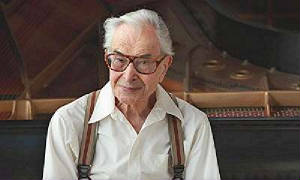
At 90, considering his family, career, and musical legacy, Dave Brubeck
says "I'm very fortunate."
"Take Five" remained a top seller all of his life.
Brubeck said his desire to play music for audiences was even greater
than being in his favorite place (home)... so he continued to travel the world at age 90. And he received our nation's
applause at the 32d Annual Kennedy Center Honors. In his last year he felt rejuvenated, and, as usual,
looking forward to his next concert. Alas, we lost him; he died in 2012.
Look for Turner Classic Movies of Bruce Ricker's
documentary "Dave Brubeck: In His Own Sweet Way," executive-produced by Clint Eastwood. Columbia Records has released a two-disc
set, "Legacy of a Legend."
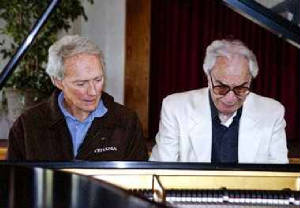
|
| Eastwood and Brubeck in their own sweet way. Photo Hank O'Neal, AP |
Brubeck was born in Concord, California. His father was a cattle rancher
and his mother was a piano teacher. After leading an Army band in Europe during World War II, Brubeck studied under French composer Darius Milhaud, who encouraged Brubeck to go into jazz.
His landmark 1959 album "Time Out" was the first
jazz album to sell a million copies on Billboard's Hot 100 chart. Its centerpiece, "Take
Five," was a tour de force in 5/4 time by sax-playing Brubeck sideman Paul Desmond.
more Brubeck interviews with Gene Seymoure and John Soeder
go to Dave Brubeck
go to NPR Piano Jazz with Dave Brubeck and Marian McPartland (58 min.)
go to Brubeck jam session at the Blackhawk in San Francisco
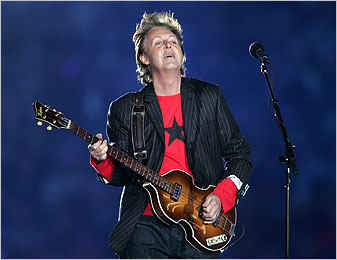
|
| Paul McCartney at 65 |
"When I'm 64" was a great
song. But Paul had no idea of the reality of it. Sir Paul McCartney will turn 70 in June 2013 and he's rethinking his lyrics
and the poetry of longevity.
"Memory Almost Full," is his song mix on the Starbucks label. From
the track "Ever Present Past:"
"I hope it isn't too late - searching for the time
that has gone so fast - the time that I thought would last - my ever present past - I've got too much on my mind - I think
of everything to be discovered - I hope there's something to find."
He's found it.
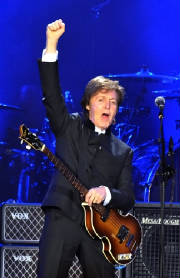
|
| McCartney at 69, at the Grammy Awards. |
Another big year. Cover story in Rolling Stone, marriage to Nancy Shevell,
and release of jazzy standards and some originals on "Kisses on the Bottom,"with music director
Diane Krall.

Pythagoreans composed music based on the mathematical
ratios of heavenly bodies.
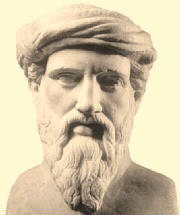
|
| Greek philosopher Pythagoras, circa 500 B.C. |
Pythagoras taught harmony of body, mind, and spirit at his
academy in Crotona. He linked the math of music to the stars in the sky. It is thought that he picked up ideas about cosmology
from Babylonians during travels to the East early in his life.
From the cosmos he drew a structure of moral principles and numerical
relationships. In the sun and moon he found math ratios in concordance with musical intervals and meters. A millennium later
his notions were revisited as "the music of the spheres."
The polyphonic music in the medieval and high gothic eras in Europe was
based on a tuning system of 12 notes in perfect fifths. Called the "Pythagorean Theorem," it was
grounded in math.
The renaissance brought about the "meantone" tuning system, with more
emphasis on thirds and sixths. But still, through countless styles and centuries, the philosopher Pythagoras
has been idealized and credited for laying the groundwork on the music-math connection.
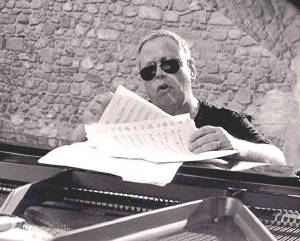
|
| Kenny Werner, author of "Effortless Mastery." |
"There is no failure in music."
- Kenny Werner
go to Kenny Werner Live
"Music is what you notice when it's no longer in your presence."
- Pat Metheny
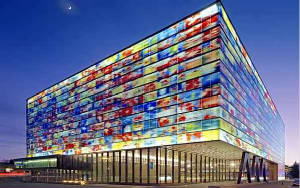
|
| Netherlands Institute for Sound and Vision. Click to enlarge. |
Preserve and Protect:
Archiving Sounds for the 25th century.
Digitizing archivists and curators are racing to save sound,
preserve film, audio, print and broadcast media. They're seeking safe storage and are alert to disaster preparedness.
The Netherlands Institute for Sound
and Vision is the new home of the national broadcasting archives-- storage for tapes of radio and television programs
of both film and magnetic media. And everything is archived in digital format. "Media Experience"
traces the history of Dutch broadcasting, and the building itself is spectacular.
It's part of an international movement to fund the
preservation of media from its beginnings. The National Media Museum in the U.K. and the Museum
of Modern Art in New York are two examples of efforts to educate and promote the appreciation of photography, sound recordings,
cinema, television, and radio.
go to slide show of NISV
go to Australia's Film and Sound
go to Nat'l Media in U.K.
go to ARL Sound Savings
About the building:

|
| Inside the Insitute for Sound and Vision |
In a world saturated in advertising and marketing images,
the Netherlands Institute for Sound and Vision is a heroic statement of architecture's stature.
A cube wrapped in a skin of cast glass panels, it is
mesmerizing from any angle. The interior volume is a luminous public atrium.
The recording archives are stacked around a deep
canyon in the five levels underground. The media museum and the media center, one of the largest audio/video archives in Europe,
are located within the five levels above ground.
Architects Willem Jan Neuteling
and Michiel Riedijk are the wizards responsible for this wildly popular spot in Hilversum, near Amsterdam.
The facade is a screen of colored relief glass depicting famous images of Dutch television.
go to slideshow of the NISV
go to views of the NISV
The word `musician' has a deeper meaning than that used
in our culture. In the old world, a musician stood at the gateway to the gods.
 |
 |
We can't
see or touch it. Language often fails to describe the vagaries of sonic textures:
Acoustics as a 'Black Art'
There are a lot of nonsense reviews by critics. With all the unknown
variables in concert hall acoustics, many writers’ descriptions are goofy-- pure hokum. Davies Hall in San Francisco
is hailed by some and panned by others. The mass of ‘report cards’ on any given hall is a pile of vague,
confusing, and contradictory subjective opinions by people who consider themselves experts.
Here is a doozie written by the great Viennese architect Adolf
Loos in 1912... Seems he’s something of a spiritualist:
"In the mortar live the sounds of great composers.
The music of our symphony orchestras impregnate the building materials, causing mysterious changes in the molecular structure,
as in the wood of old violins. But brass instruments have a bad effect, and military music played in the Bösendorfer Hall could ruin its acoustics within a week. For the same reason, opera houses have poor acoustics
on the side where the brass players sit."
|
|
 |
 |

|
| Bob Dylan in 1963 - Don Hunstein |
Bob
Dylan is a prolific song man, a lyricist who nudges his words into tunes until he likes a
particular mesh of language and sound.
In 1962 he cut his first album-- and 44 years later comes
his 44th album: "Modern Times."
He thinks his best sounds were his mid-sixties albums-- Bringing It
All Back Home, Highway 61 Revisited, and Blonde on Blonde-- because he liked his voice better then. His vocal chords
may be wearing down but his songwriting still nails his 'sound.' And with more than 500 songs to his credit, he's still at
it.
"He not busy being born is busy dying."
- Bob Dylan
"Music is the ultimate teacher."
- Vasily Kandinsky, painter.
|
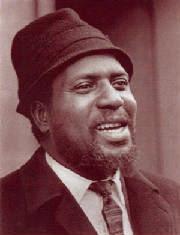
|
| Thelonious Sphere Monk |
Thelonious Sphere Monk
lived up to the mystical connotations of his name. He was a pensive composer,
preoccupied and absorbed by his music. Quiet and somnolent by nature, he often gave the impression that he was asleep when
he was thinking. And he was famously reticent in interviews.
But oh, he got excited when he was at the piano. He’d
work through progressions and rhythms for days on end to the exclusion of everything else. He said he "dug the stuff out."
But he left it to other musicians to package the goods and deliver it to the audience.
Continue by clicking the link below, and read the 1964
Time Magazine cover story on Monk by Barry Farrell.
more on Monk
"Anybody can play a composition and use far-out
chords and make it sound wrong. It's making it sound right that's not easy."
- Thelonious Sphere Monk
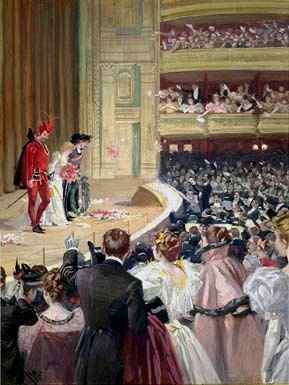
|
| Metropolitan Opera, New York City, 1883. |
Divas, tenors, and bel canto fireworks coming to the multiplex
near you:
Peter Gelb, the new general manager of the
Metropolitan Opera, is a tech-savvy former record company executive who wants to make opera more
accessible and coax populist appeal.
Not ‘preaching to the converted,’ he’s luring younger
audiences by revamping the Met’s media reach.
So the Met is opening its archive of 1400 radio performances for streaming
and downloading. Its music will be on satellite radio and on-demand cable. And live opera simulcasts are headed to theaters
in the U.S., the U.K., and Canada.
The sight and sound of the Met will be in about 300 movie theaters–
in spectacular high definition and surround sound. Tickets will sell for about 18 dollars– a deal considering that tickets
at the 4,000-seat Met go for as high as $320.
The 125-year-old Met is also forging an advertising campaign, spending
half a million to plaster New York subways with ads for ‘Madama Butterfly.’ Nothing stuffy or highbrow about that.
go to the Met's broadcasts and recordings
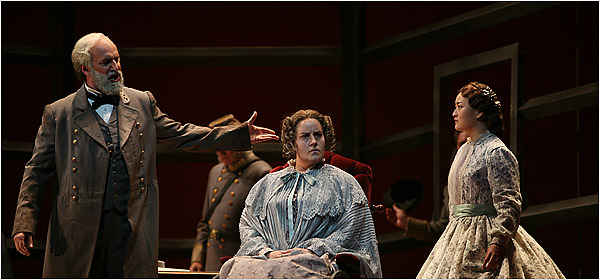
|
| San Francisco Opera |
|
 |
|
|
|

